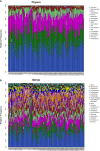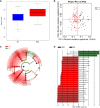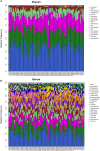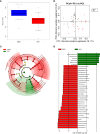Salivary Microbiome Variation in Early Childhood Caries of Children 3-6 Years of Age and Its Association With Iron Deficiency Anemia and Extrinsic Black Stain
- PMID: 33869076
- PMCID: PMC8044945
- DOI: 10.3389/fcimb.2021.628327
Salivary Microbiome Variation in Early Childhood Caries of Children 3-6 Years of Age and Its Association With Iron Deficiency Anemia and Extrinsic Black Stain
Abstract
ECC is a common clinical manifestation of the oral cavity in childhood and Iron deficiency-anemia (IDA) is a high-risk factor but extrinsic black stain on the tooth surface is a protective factor for caries. There is limited information about oral microecological change in early children who suffer from ECC with IDA and extrinsic black stain (BS). This study enrolled 136 children aged 3-6 years. Dental caries and teeth BS were examined. Saliva was collected for 16S rRNA gene and fingertip blood were for Hemoglobin test. There are 93 ECC including 13 with IDA (IDA ECC) and 80 without IDA (NIDA ECC) and 43 caries free (CF) including 17 with BS (BSCF) and 26 without BS (NBS CF). Statistical analysis of microbiota data showed differences of the oral flora in different groups. The oral flora of the IDA ECC group had a high diversity, while the BSCF group had a low diversity. The bacterial genera Bacillus, Moraxella, and Rhodococcus were enriched in the IDA ECC while Neisseria was enriched in the NIDA ECC. Neisseria only exhibited high abundance in the BSCF, and the remaining genera exhibited high abundance in the NBSCF. Interestingly, the BSCF had the same trend as the NIDA ECC, and the opposite trend was observed with IDA ECC. We established random forest classifier using these biomarkers to predict disease outcomes. The random forest classifier achieved the best accuracy in predicting the outcome of caries, anemia and black stain using seven, one and eight biomarkers, respectively; and the accuracies of the classifiers were 93.35%, 94.62% and 95.23%, respectively. Our selected biomarkers can achieve good prediction, suggesting their potential clinical implications.
Keywords: children 3-6 years of age; early childhood caries (ECC); extrinsic black stain (BS); iron deficiency anemia (IDA); salivary microbiome variation.
Copyright © 2021 Han, Yue, Lin, Du, Wang, Wang, Kong, Wang, Gao, Ma and Bu.
Conflict of interest statement
The authors declare that the research was conducted in the absence of any commercial or financial relationships that could be construed as a potential conflict of interest.
Figures






Similar articles
-
Iron deficiency anemia associated factors and early childhood caries in Qingdao.BMC Oral Health. 2022 Mar 31;22(1):104. doi: 10.1186/s12903-022-02127-z. BMC Oral Health. 2022. PMID: 35361164 Free PMC article.
-
[The effect of iron deficiency anemia and black stain on the microbial community of dental plaque in young children with early childhood caries].Zhonghua Yu Fang Yi Xue Za Zhi. 2024 Dec 6;58(12):1976-1986. doi: 10.3760/cma.j.cn112150-20240628-00522. Zhonghua Yu Fang Yi Xue Za Zhi. 2024. PMID: 39710477 Chinese.
-
Comparison of the salivary and dentinal microbiome of children with severe-early childhood caries to the salivary microbiome of caries-free children.BMC Oral Health. 2019 Jan 14;19(1):13. doi: 10.1186/s12903-018-0693-1. BMC Oral Health. 2019. PMID: 30642327 Free PMC article.
-
Early Childhood Caries and Iron Deficiency Anaemia: A Systematic Review and Meta-Analysis.Caries Res. 2022;56(1):36-46. doi: 10.1159/000520442. Epub 2021 Nov 8. Caries Res. 2022. PMID: 34749377
-
Does Serum Ferritin Level Affect Early Childhood Caries?-A Review.Int J Clin Pediatr Dent. 2025 Apr;18(4):487-490. doi: 10.5005/jp-journals-10005-3116. Epub 2025 May 19. Int J Clin Pediatr Dent. 2025. PMID: 40469822 Free PMC article. Review.
Cited by
-
Iron deficiency anemia associated factors and early childhood caries in Qingdao.BMC Oral Health. 2022 Mar 31;22(1):104. doi: 10.1186/s12903-022-02127-z. BMC Oral Health. 2022. PMID: 35361164 Free PMC article.
-
Oral microbial profiles of extrinsic black tooth stain in primary dentition: A literature review.J Dent Sci. 2024 Jul;19(3):1369-1379. doi: 10.1016/j.jds.2024.02.028. Epub 2024 Mar 8. J Dent Sci. 2024. PMID: 39035270 Free PMC article. Review.
-
Iron Deficiency Anemia and Its Impact on Oral Health-A Literature Review.Dent J (Basel). 2024 Jun 7;12(6):176. doi: 10.3390/dj12060176. Dent J (Basel). 2024. PMID: 38920877 Free PMC article. Review.
-
Impact of ovalbumin allergy on oral and gut microbiome dynamics in 6-week-old BALB/c mice.Front Microbiol. 2024 Sep 3;15:1439452. doi: 10.3389/fmicb.2024.1439452. eCollection 2024. Front Microbiol. 2024. PMID: 39290514 Free PMC article.
-
Epidemiological and Microbiome Characterization of Black Tooth Stain in Preschool Children.Front Pediatr. 2022 Jan 26;10:751361. doi: 10.3389/fped.2022.751361. eCollection 2022. Front Pediatr. 2022. PMID: 35155301 Free PMC article.
References
-
- (2016. b). Policy on Early Childhood Caries (ECC): Classifications, Consequences, and Preventive Strategies. Pediatr. Dent. 38 (6), 52–54. - PubMed
Publication types
MeSH terms
Substances
LinkOut - more resources
Full Text Sources
Other Literature Sources
Medical
Research Materials
Miscellaneous

